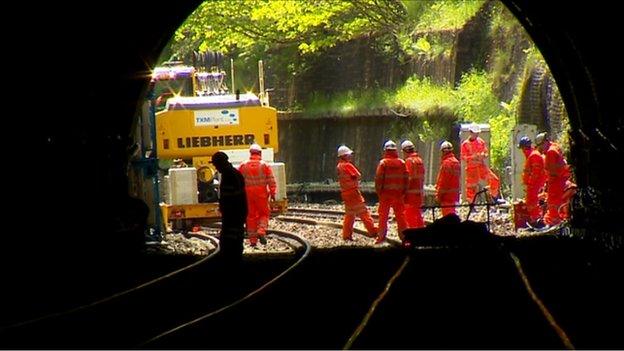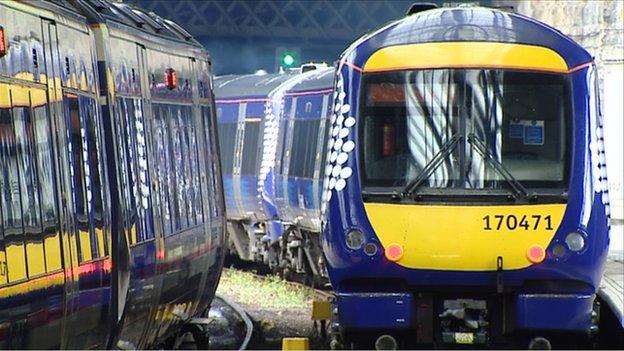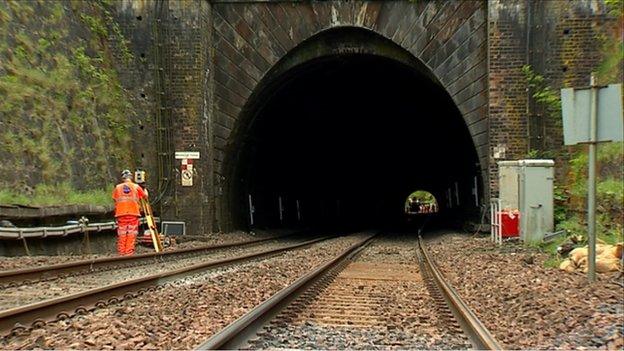Weeks of disruption for Edinburgh-Glasgow rail users
- Published
Rail passengers in central Scotland are being urged to plan in advance for the closure of the main Edinburgh to Glasgow via Falkirk High line
Train passengers in Scotland's central belt face six weeks of disruption from this weekend when work begins on the Winchburgh tunnel.
The closure of the tunnel near Linlithgow in West Lothian will mean rail services between Edinburgh and Glasgow will be severely hit.
The work is part of a £750m upgrade to enable faster, bigger and greener electric trains to run on the line.
The disruption will last from 13 June to 27 July.
Engineers said the tunnel closure was necessary so tracks could be lowered to create space for overhead power lines for the new trains, which will be introduced at the end of next year.

Work on the Winchburgh tunnel will hit the Edinburgh-Glasgow rail line for six weeks
The upgrade is the latest phase of the Scottish government's Edinburgh Glasgow Improvement Programme (EGIP).
Train operator ScotRail has a dedicated website to advise on the disruption, external, which will mainly hit travel between Glasgow - or Stirling/Dunblane - and Edinburgh but it will also have a knock-on effect in areas such as the Fife Circle.
Many passengers will have longer journeys or bus replacements. ScotRail advised passengers to add at least 30 minutes to their planned journey times.
The closure will mean passengers looking to travel end-to-end from Glasgow to Edinburgh will no longer be able to take a train from Queen Street high level platforms, as the trains will only go as far as Linlithgow.
Instead, they will have to switch to the slower Queen Street low level trains or travel on the longer route from Glasgow Central Station.

How will train works affect passengers?

ScotRail said the main routes affected would be:
Glasgow Queen Street High Level - Falkirk High - Edinburgh
Alloa / Dunblane / Stirling - Edinburgh
Linlithgow - Edinburgh Park
Edinburgh - Glenrothes (Fife Circle)
In addition, the following services will be busier than normal in both directions:
Glasgow Queen Street Low Level - Airdrie/Bathgate - Edinburgh
Glasgow Central - Shotts/Motherwell - Edinburgh

Rodger Querns, programme director of EGIP for Network Rail, said the tunnel work over the next six weeks would see the track removed and the floor of the tunnel lowered to create headroom to install new electrification equipment.
He said: "We can't avoid the work in Winchburgh tunnel. We do appreciate the inconvenience this will cause passengers. We have planned the work meticulously and are working hard to minimise that disruption.
"We are working round-the-clock. We have engineers on the site 24/7 to get the railway back running as planned on 27 July."
Phil Verster, managing director of train operator ScotRail Alliance, said: "The EGIP programme is a £750m investment in this very important corridor between Edinburgh and Glasgow.
"It electrifies the line and the magnificent benefit it brings for our customers is we are going to have longer trains, about 30% more capacity, shorter journeys because we are going to run trains faster and shave about eight to 10 minutes off a 50-minute journey time, and it is going to be greener as well.
"So on all counts it is good for customers and good for the country."

Analysis by BBC Scotland transport correspondent David Miller

About 150 years ago when this tunnel was built the challenge was creating enough headroom to allow the funnels of steam locomotives to fit through as they thundered along the track.
Today the challenge is about making enough space for the overhead lines for electric trains.
The engineers can't go up so they have to go down, dropping the level of the entire track.

Some have questioned why the rail improvement work was taking place at the same time as major upgrades to the road network in Central Scotland.
Work on the £500m M8 M73 M74 Motorway Improvements Project in Lanarkshire is already leading to disruption as traffic restrictions are in force.
Transport Minister Derek Mackay advised people to plan their journeys and assured them it would be worth it.
He said: "For both the road and rail network the best time to do it would be over the summer. That's when the least people will be travelling.
"These are major improvements and they are necessary improvements. We can't just let the infrastructure disintegrate.
"This is better than that. It is not just maintenance, it is upgrading of our rail and road infrastructure so it is fit for the future and can unlock even more economic potential and improve the connections in our country."
Mr Querns said the EGIP project would continue on sections of the line over the next year but most of the work would be carried out at night.
He said: "Next year we will be working in the Queen Street tunnel clearing that for electrification in April 2016."
Mr Verster said Glasgow Queen Street would be "transformed" by the changes, with the whole concourse being remodelled.
He said: "It will put Glasgow Queen Street on a par with what we have at St Pancras or King's Cross. It is going to be absolutely stunning."